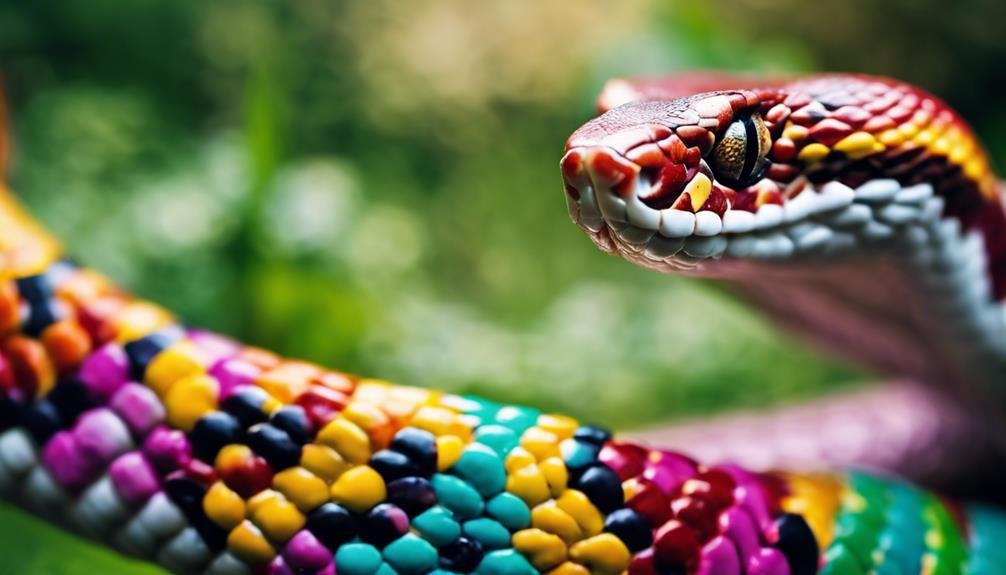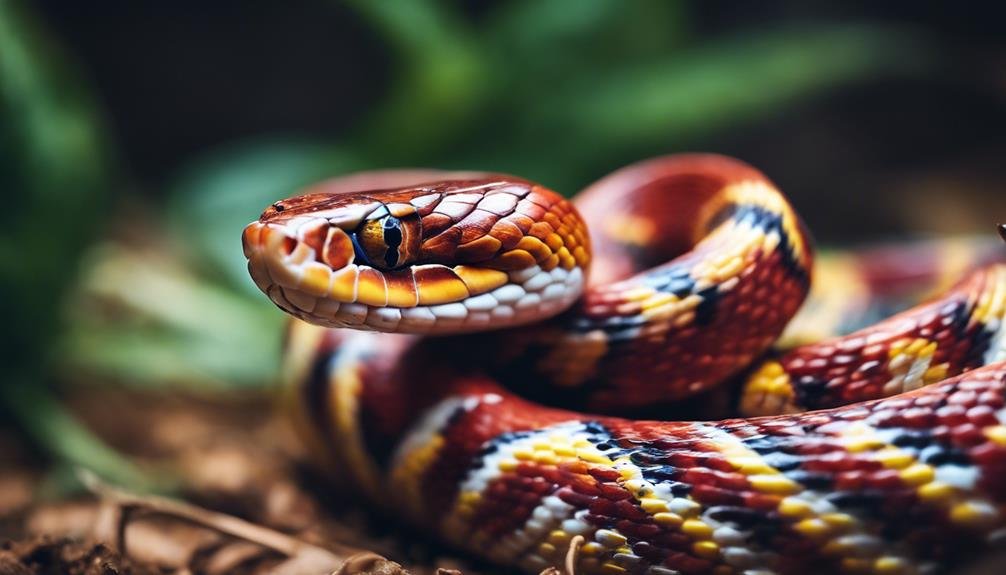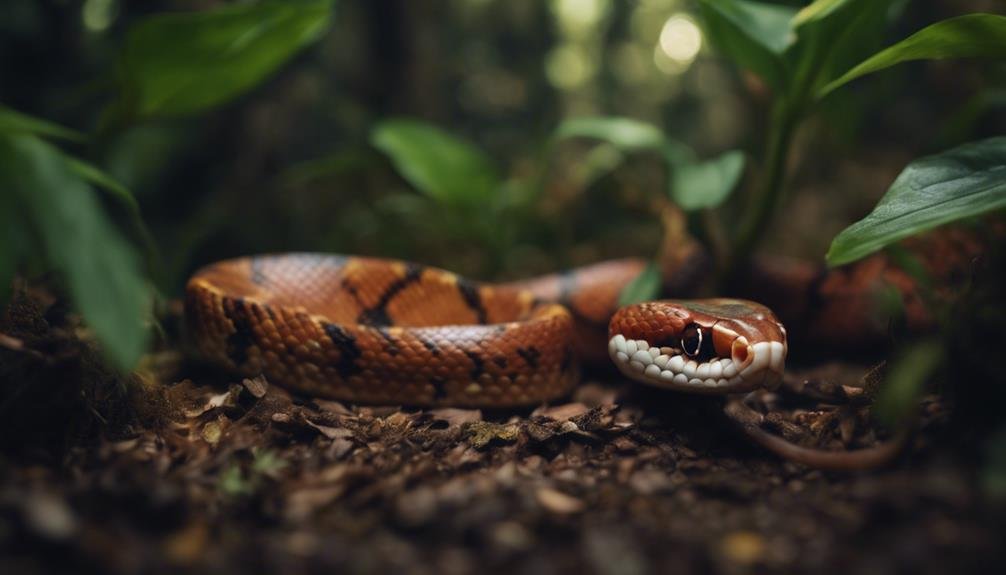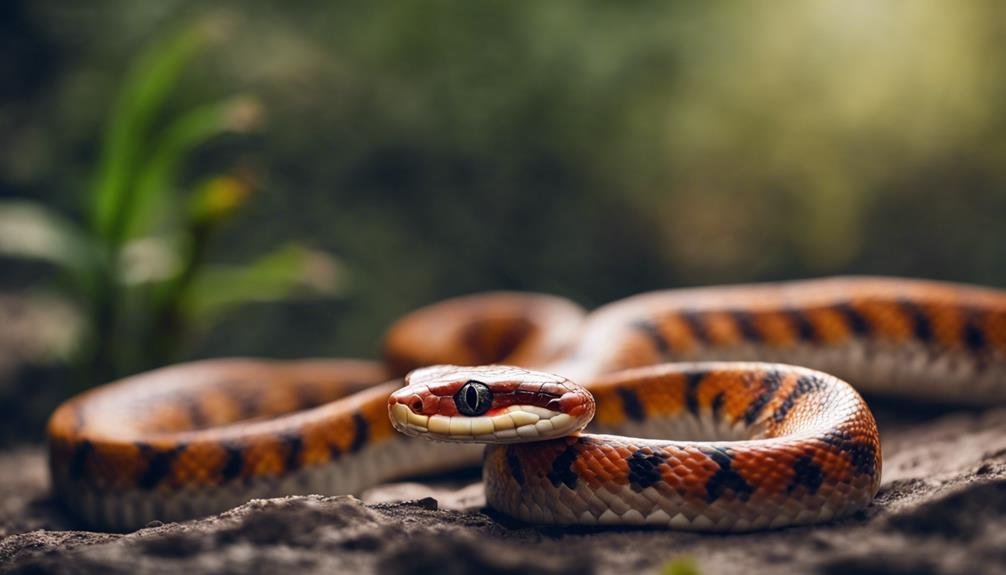You might wonder if corn snakes are blind, given their often motionless, contemplative gaze. They’re not, but what they see vastly differs from your vision. Imagine seeing the world in variations of gray, with the added ability to detect ultraviolet light, enhancing their hunting prowess. Yet, their lack of color vision and limited night vision might seem a drawback at first glance. However, their specialized sight and keen sense of smell equips them uniquely for survival. Are you curious about how these adaptations affect their daily lives? There’s more to uncover about their intriguing world.
Corn snakes, a popular species among reptile enthusiasts, have unique eyesight and behavior that fascinate many. Contrary to common misconceptions, corn snakes are not blind. Their eyes, adapted for their natural habitat, provide sufficient vision for hunting and navigating their environment.
Key Takeaways
- Corn snakes are not blind; they can detect ultraviolet light and see grayscale variations.
- Their vision specializes in detecting mid-range visible and ultraviolet light, essential for hunting and survival.
- Corn snakes have limitations in their night vision and cannot rely on it as effectively as they do on their sense of smell.
- They cannot perceive colors as humans, mainly seeing the world in grayscale.
- Despite these visual limitations, corn snakes complement their sight with a keen sense of smell, using their forked tongues to navigate and hunt.
Corn Snake Vision Basics
Corn snakes can’t see colors but can detect ultraviolet light uniquely, helping them hunt and navigate their environment. This specialization allows them to see in ways that go beyond human capabilities. When observing corn snakes, it’s intriguing to ponder that they perceive the world differently. They likely see variations of grayscale, which aids them in identifying shapes and movements that might indicate the presence of prey or predators.
This grayscale vision doesn’t mean they’re at a disadvantage. Their ability to detect ultraviolet light compensates for their lack of color vision. This feature is important in their hunting strategy, enhancing their ability to spot trails left by rodents, their primary prey. Additionally, corn snakes use scent extensively to track down their meals. They mightn’t have heat pits for infrared sensing like some snakes, but their keen sense of smell and specialized vision make them formidable hunters.
Understanding these aspects of corn snakes’ vision sheds light on their behavior, revealing how well-adapted they are to their environment despite being unable to see colors.
Understanding Their Eyesight
Delving into their eyesight, you’ll find that corn snakes possess a crucial visual system tailored to their survival in the wild. Unlike many animals, they don’t have eyelids. Instead, their eyes are protected by transparent scales known as eye caps. These eye caps are essential for their vision, especially since these snakes frequently burrow, which could potentially damage their eyes. During shedding, corn snakes have the opportunity to clean and renew these protective caps, ensuring their vision remains unobstructed.
- Their eyes are specialized to detect ultraviolet light and mid-range visible light.
- Eye caps protect their vision during burrowing activities.
- Sensitivity to scent complements their visual abilities, aiding in prey detection.
- Lack of heat pits means reliance on scent and visual cues.
- Unique visual adaptations are optimized for survival and hunting in their natural habitat.
Understanding the intricacies of corn snakes’ eyesight reveals how they’ve evolved to rely on a blend of scent and visual cues to navigate their environment, hunt prey, and avoid predators. Though their eyes are not as versatile as some predators, they are perfectly adapted to their specific needs and lifestyles.
Color Perception in Corn Snakes


Delving deeper into their sensory capabilities, it is important to note that corn snakes likely experience the world without the vibrancy of color, seeing instead in shades of gray. Unlike some of their reptilian counterparts, such as certain lizards, amphibians, and turtles with color vision, corn snakes’ perception leans toward a grayscale view. This doesn’t hinder their survival, as these creatures rely more on other senses to navigate their environment.
| Aspect of Perception | Description |
|---|---|
| Color Vision | Corn snakes likely see in grayscale, lacking the ability to perceive colors. |
| Red Screens | Red plastic screens may appear as solid obstacles due to their limited color perception. |
| Reliance on Senses | They prioritize scent and movement over color differentiation, focusing on what truly matters for their survival. |
Given this, it’s interesting to ponder how different the world appears through the eye cap of a corn snake. Their environment, filled with potential prey and predators, is interpreted without color, showcasing how adaptable nature can be. Color perception may not be a significant issue for corn snakes, as they’ve evolved to thrive without it, honing in on what’s essential for their success in the wild.
Night Vision Capabilities
Given their daytime hunting habits, you might wonder how well corn snakes see at night. They can’t rely on their vision in the dark as much as they do on their ability to sense heat and movement.
Comparing their night vision to human sight reveals significant limitations, emphasizing their dependence on other senses for moving and hunting in low-light conditions.
Night Vision Limitations
Corn snakes find their night vision capabilities greatly reduced when moving through the darkness, relying more on other senses to guide them. Their eyes, optimized for daylight, see less efficiently in low light, highlighting their night vision limitations.
- Shadows merge into a single blanket of obscurity, obscuring the details of their surroundings.
- Moonlit nights offer scant assistance, barely improving their visual acuity.
- The familiar becomes unfamiliar as their daytime clarity dims under the cloak of night.
- Reliance shifts from sight to the subtle whispers of scent carried in the air.
- Every rustle of leaves underfoot becomes a beacon, guiding their path more than the weak glow of starlight.
Understanding these limitations is key to meeting their needs, especially in captivity.
Sensing Heat Prey
Corn snakes, while lacking the heat-sensing pits of their reptilian cousins, compensate with a keen sense of scent for tracking prey. Despite not sensing heat directly through specialized organs, their behavior is driven by an acute awareness of scent and the ability to track movements around them.
This unique adaptation means you’ll find them using a combination of scent and subtle visual cues to hunt. Their eyes, fine-tuned to detect ultraviolet light, play a pivotal role alongside their olfactory prowess. This dual approach effectively allows them to locate prey, even without heat detection abilities.
Understanding their sensory capabilities sheds light on their hunting strategies and overall behavior, demonstrating how they’ve evolved to thrive in their environment without directly sensing heat.
Comparing Human Sight
Surprisingly, unlike humans, corn snakes cannot see well in low light conditions, as their eyes are tuned more for detecting ultraviolet light. While you might take your ability to navigate a dimly lit room for granted, corn snakes operate differently in the dark. Their world isn’t illuminated by the faint moonlight guiding us at night. Instead, they rely on other senses to find their way and hunt.
- Moonlit paths that guide humans at night
- The glow of city lights, barely perceptible to corn snakes
- Shadows that we can discern but are invisible to them
- Starlight that helps humans see yet offers no aid to corn snakes
- The faint outline of objects in the dark, clear to us but obscured to them
Corn snakes have evolved perfectly for their environment, but you’ve got the upper hand when it comes to seeing in the dark.
Limitations of Their Sight
Often, corn snakes’ vision doesn’t allow them to see the full spectrum of colors, limiting their perception to what’s likely a grayscale world. This specialized vision is more attuned to detecting ultraviolet light rather than the full visible light spectrum that humans enjoy. It’s an essential adaptation that can help them in their natural environments, even if it means they miss out on the vividness of the world in color. For instance, what you might see as a transparent red plastic screen could appear as a solid barrier to a corn snake due to their unique visual limitations.
Understanding these visual limitations is vital to interpreting their behavior and interactions within their habitat. Corn snakes rely more on scent and visual cues that don’t require color perception for survival. This reliance on alternative senses for survival hints at how they’ve evolved to thrive despite what might seem like a significant handicap. Their world mightn’t be painted in the bright colors we see, but it’s perfectly suited to their survival needs, explaining how they hunt, navigate, and avoid predators.
The Role of Other Senses


As you explore the world of corn snakes, you’ll find that their sight isn’t their only key to survival.
They’re equipped with a remarkable ability to sense heat and differentiate scents and tastes, which guides them in finding their way and guarantees they’re adept at locating prey, even in complete darkness.
Sensory Smell and Taste
Corn snakes heavily depend on their sense of smell to explore and move around. They utilize their forked tongues to gather and analyze scent particles from their surroundings. While their ability to see might have limitations, their keen sense of smell bridges the gap, allowing them to interact effectively with the world around them.
- The flicking of a tongue into the air, tasting the environment.
- A subtle approach towards a hidden prey, guided purely by scent.
- The transfer of invisible scent clues to Jacobson’s organ.
- We are moving through the dark, relying on the scent trails left behind.
- The discernment between potential food sources and non-edible objects, all through the power of scent.
Understanding their reliance on sensory smell and taste is key to appreciating how corn snakes perceive and engage with their environment.
Heat Detection Abilities
Corn snakes can’t sense heat through specialized organs unlike some reptilian counterparts. This means their heat detection abilities are quite limited.
Corn snakes can’t see or sense the warmth of their prey or surroundings like snakes equipped with infrared-sensitive pits. Instead, they rely heavily on other senses, particularly scent and sight, to navigate and hunt in their environment.
These sensory adaptations play an essential role in their survival, allowing them to track down prey through visual cues and the scents left behind. Understanding that corn snakes can’t detect heat helps explain much of their behavior in natural habitats, highlighting how they’ve adapted to see and interact with the world without this particular ability.
Identifying Prey and Predators
To navigate their environment effectively, corn snakes utilize their keen sense of scent alongside their specialized vision to differentiate between prey and predators. They’re not just slithering through their territory aimlessly; they’re on a constant lookout, using their abilities to see and smell to make vital decisions for survival. Their vision, particularly adept at detecting ultraviolet light, plays a pivotal role in this process.
Imagine a world where you can see the unseen, where the faintest traces of ultraviolet light guide you to your next meal or away from danger. This is the reality for corn snakes. Their world is illuminated not just by the sunlight we see but by the vibrant glow of ultraviolet, highlighting paths to prey and warning signs of predators.
- The subtle movement of a rodent in the underbrush catches their attention instantly.
- A shadow overhead might signal a predatory bird urging caution.
- Flickers of UV light off the scales of another snake could mean competition or threat.
- The rustle of leaves might betray the presence of a meal just within reach.
- A sudden, sharp movement in their peripheral vision can trigger their swift escape response.
This intricate dance of sensing and reacting defines their existence, with each decision influenced by their ability to see and smell the world around them.
How Do Corn Snake Morphs Affect Their Vision and Health?
Corn snake color variations can affect their vision and health. Some morphs, like the albino morph, can have poor vision due to eye abnormalities. In the case of the spider morph, certain morphs may be more prone to health issues, such as neurological problems. It’s important to consider these factors when selecting a pet corn snake.
Navigating Their Environment


Moving through their environment, corn snakes rely heavily on scent and visual cues, including their unique ability to detect ultraviolet light to find their way. They don’t see the world in colors like we do; instead, they likely see everything in varying shades of gray. But don’t mistake this for a limitation. Combined with their ultraviolet sight, this grayscale vision is perfectly suited for their survival.
| Aspect of Navigation | Sense Utilized | The benefit to Corn Snake |
|---|---|---|
| Locating Prey | Smell + Vision | Pinpoints prey even in low light |
| Avoiding Predators | Vision | Detects subtle movements |
| Exploring Terrain | UV Light Detection | Identifies safe paths |
| Finding Mates | Smell + UV Light | Enhances social interactions |
| Seeking Shelter | Vision + Smell | Identifies safe hideaways |
How Corn Snakes Use Their Vision
Corn snakes rely heavily on their sense of sight to detect prey such as mice and rats. Their eyesight is complemented by heat pits, which are sensitive to infrared radiation. These pits help corn snakes locate warm-blooded prey even in low-light conditions. This nocturnal hunting ability allows cornsnakes to thrive in various habitats.
Factors Affecting Corn Snake Eyesight
Several factors can impact a corn snake’s vision, including eye caps, damage from improper shedding, and health issues. Providing the right environment and care in captivity is crucial to maintaining their eyesight. Regular checks by a vet can help prevent and treat any vision problems.
Enhancing Your Corn Snake’s Habitat
Creating an ideal enclosure miming their natural habitat can improve their health and eyesight. Ensuring proper heat, humidity, and light levels can help your corn snake exhibit natural behaviors and maintain its vision.
Conclusion
To conclude, you’ve learned that corn snakes aren’t blind, but they do see the world differently from us. They lack color vision, seeing in shades of gray and ultraviolet light, which helps them track prey.
Although their night vision isn’t strong, corn snakes are adept at using scent and slight visual cues to navigate and hunt in the dark. So, while their sight has limitations, corn snakes effectively use their senses to identify threats and find food, thriving in their natural habitats.
Related Article
https://thereptileguide.com/the-best-reptile-care-products/
https://thereptileguide.com/how-long-can-a-bearded-dragon-go-without-eating/


